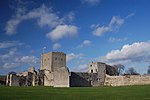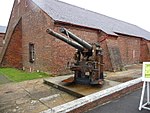Portsmouth Harbour

Portsmouth Harbour is a 1,264.2-hectare (3,124-acre)/12.6 km2 (4.9 sq mi) biological Site of Special Scientific Interest between Portsmouth and Gosport in Hampshire. It is a Ramsar site and a Special Protection Area. It is a large natural harbour in Hampshire, England. Geographically it is a ria: formerly it was the valley of a stream flowing from Portsdown into the Solent. At its north end is Portchester Castle, of Roman origin and the first fortress built to protect the harbour. The mouth of the harbour provides access to the Solent. It is best known as the home of the Royal Navy, HMNB Portsmouth. Because of its strategic location on the south coast of England, protected by the natural defence of the Isle of Wight, it has since the Middle Ages been the home to England's (and later Britain's) navy. The narrow entrance, and the forts surrounding it gave it a considerable advantage of being virtually impregnable to attack from the sea. Before the fortifications were built the French burned Portsmouth in 1338. During the civil war parliamentary forces were able to carry out a successful cutting-out expedition within the harbour and capture the six-gunned Henrietta Marie.In modern times, the harbour has become a major commercial ferry port, with regular services to Caen, France, Cherbourg, France, St Malo, France, The Channel Islands and the Isle of Wight. There is a passenger ferry to Gosport. It is also a major area for leisure sailing. In 2001 the Gunwharf Quays development, was opened on the site of HMS Vernon (a former naval shore establishment).
Excerpt from the Wikipedia article Portsmouth Harbour (License: CC BY-SA 3.0, Authors, Images).Portsmouth Harbour
Portsmouth
Geographical coordinates (GPS) Address Nearby Places Show on map
Geographical coordinates (GPS)
| Latitude | Longitude |
|---|---|
| N 50.8235 ° | E -1.1228 ° |
Address
Tipner
PO2 8RD Portsmouth
England, United Kingdom
Open on Google Maps









